Pears are excellent backyard trees. They produce a fruit sweeter and juicier than most apples; a fruit that easily ripens off the tree.
After careful selection and early training, pear trees will require generally less upkeep than other fruiting trees. They live longer than most apple trees and they require less pruning and thinning.
Pears will grow almost everywhere apples grow and are nearly as cold-tolerant. A standard pear tree requires about the same space as an apple tree and can be pruned to about 20 feet tall. Semi-dwarf pear trees grow to about 12 feet tall.
Related article:
There are two types of pears: European pears–with their classic pear shape–are harvested before they are ripe and held in storage until they ripen and are ready for eating; Asian pears–which are rounded and crisp much like an apple–are harvested ripe from the tree.
There are pears for fresh eating out of hand and pears for cooking, usually poached.
Here is your complete guide to growing pear trees.
Best climate to grow a pear tree
- Most pears require slightly warmer winters than apples; most are not much colder than 20°F. A few pear varieties can survive winter temperatures as low as -20°F.
- Pears need at least 600 hours of winter chill, that is 45°F or lower each year to produce a crop; 900 hours of chill is even better.
- Pears are early spring bloomers; frost during bloom time will cause blossoms to drop and the crop to fail. In cold winter regions, protect pears from frost at bloom time; situate trees south-facing or on a slope where they get early morning sun and warmth and are protected from lingering frost.
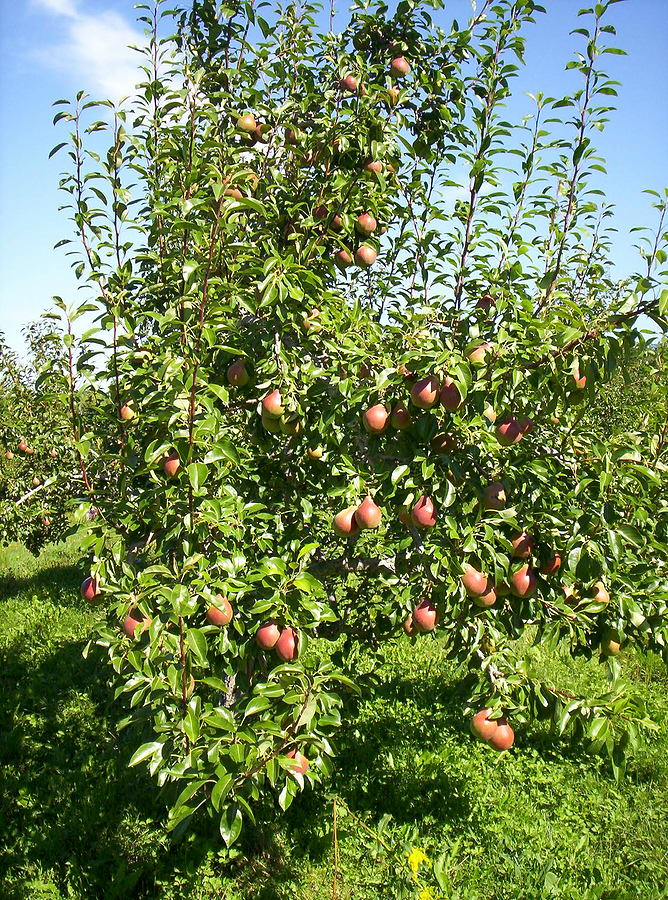
Before you buy and plant a pear tree consider the following
- Space to grow and form the tree. How much space do you have? This will determine the form of the tree you choose–freestanding or wire-trained.
- Size of tree and type of rootstock. What size tree will fit the space? The ultimate size of a pear tree is determined by its rootstock.
- Flowering time and harvest. When will the tree flower? This will determine pollination–pears require a second cultivar or variety to cross-pollinate. Flowering time–early, mid, or late season–will determine, in turn, harvest time.
- Use of fruit: fresh eating or cooking. What kind of pear do you want? Like apples, there are pears for fresh eating–dessert pears–and pears for cooking–culinary pears. Consider the cultivars and variety of pear you’d like to grow and how it will be eaten.
Space needed to grow pear trees
The space you have to grow a pear tree will determine the form of the tree. Pears can be trained in many of the ways as apples. European pears are commonly trained to be a central leader (shaped like a Christmas tree) or modified central leader form. Asian pears are usually trained to an open center (shaped like a vase). Here are pear tree forms and the space they require:
Standard-size pear trees
Standard-size pear trees can grow to 40 feet tall if not pruned and have a spread of 30 to 40 feet. Standard pears are commonly pruned from 15 to 25 feet tall with an equal spread. Plant standard pear trees 18 to 25 feet apart. Standard pears fruit in 4 to 8 years and can live for 75 years. Standard-size pear trees are not commonly planted in home gardens. Mostly they are planted in commercial orchards.
Semi-dwarf pear tree
Semi-Dwarf pear trees will grow to 25 feet tall if not pruned and will grow as wide. Semi-dwarf pears are commonly pruned from 12 to 15 feet tall with an equal spread. Semi-dwarf pears bear fruit in 3 to 5 years and can live to 60 years old. These trees can be pruned to a central leader (a single main shoot rising from the trunk) or several leaders–sometimes pruned to a cup shape. Semi-dwarf trees are usually grafted trees; a shoot (called a scion) taken from a pear variety (which transmits the fruiting qualities of the variety) is grafted onto a particular rootstock (to provide vigor to the grafted scion) which determines the size of the tree.
Cordon pear trees
Cordon pear trees are pruned to about 30 inches tall. A cordon is commonly a dwarf pear tree whose growth is trained to a single main stem or leader (called cordon) or multiple leaders (called double “U” cordon with two vertical leaders, or multiple cordons with three or four vertical leaders); the leaders are trained upright or oblique. Cordons are suited for small spaces as the tree is trained to a horizontal plane rather than allowed to form a bush or tree.
Cordons produce fruit on short side shoots. Cordons must be pruned regularly during the growing season to keep their shape and size. The leaders on these trees are commonly trained at an angle of 45 degrees by being tied to two wires stretched at heights of about 2½ and 5 feet between posts rising 7 feet out of the ground and placed at 10-foot intervals. Cordon pear trees should be planted at a distance of 1½ to 3 feet apart in rows 6 to 10 feet apart. Cordon trees are usually planted at about one year old.
Espalier pear trees
Espalier pear trees: standard and dwarf pear tree varieties can be grown as espaliers–usually kept to 8 or 9 feet tall by pruning. An espalier pear is trained with a central vertical trunk or leader and two or three tiers of horizontal branches or arms trained to radiate to the left and right of the central leader. Espaliers are commonly trained to horizontal wires stretched 24 inches apart. Espaliers, like cordons, are good for small spaces. Plant pear trees for espalier 12 to 15 feet apart. Espalier pear trees are usually planted when three to four years old.
Fans or palmettes
Fans or palmettes are pear trees trained to a small height on wires. These trees can be shaped as a pyramid or triangle, a fan–usually with two main leaders or ribs radiating from a short trunk with sub laterals forming a fan shape, or palmettes, a cross between an espalier and a fan with a central leader and arms radiating at angles rather than horizontally–shaped similar to an open palm. Similar to cordons or espaliers but smaller, these trees require less maintenance. Pyramids, fans, and palmettes commonly grow to about 5 feet tall on horizontal wires 18 inches and 3 feet above the ground. These forms can be planted 3 ½ to 5 feet apart in rows 7 to 10 feet apart. The plants are usually planted when 3 to 4 years old.
Stepovers
Stepovers are knee-high, single, horizontal cordons bent at right angles close to the ground. These low horizontal trees can be used in small gardens as decorative borders. Stepovers are trained just as cordons only lower.
Size of a pear tree
The size of a pear tree is determined by its rootstock. Pear trees are commonly grafted onto quince or specially developed rootstock. A grafted tree combines a rootstock and a shoot (called scion) taken from a fruiting pear variety. The scion transmits the fruiting qualities of the variety and the rootstock provides vigor and determines the size of the tree. Unlike apple trees, no fully dwarfing rootstocks are available for pears. Pear trees are either standard size (about 20 to 40 feet tall) or semi-dwarf (about 12 to 20 feet tall).
Where to plant a pear tree
Pears grow best in heavy loam soil. Pears will tolerate poor soils and even clay soils but are less productive in very heavy soils. Set trees at the same depth that they grew in nursery or nursery containers with the graft above ground level. Prune back the top growth so that it equals the amount of root growth.
- Plant pears where they are protected from wind and frost—especially during their bloom time. Plant pears in a sheltered, sunny spot, out of the wind.
- Plant pears in well-drained loam or compost-rich soil. Pears can tolerate damp, heavy clay soil though it’s not optimal.
- Pears grow best when the soil pH is about 6.5.
How to plant a pear tree
- Plant pear trees in spring or fall when trees are dormant.
- If you live in a cold winter region, it’s best to plant bare-root pears in spring.
- Container-grown and ball-and-burlapped pears can be planted at any time of the year when the soil is workable.
- Avoid planting pear trees when the weather is hot and dry.
- Bare-root pears are usually one or two years old; container-grown trees may be older. Choose a tree at least one-year-old tree and ½ inch to 1 inch in diameter that is 4 to 5 feet tall with one to three branches.
- Prepare a planting site in full sun that is sheltered from a prevailing breeze or wind.
- Dig a hole half again as deep and twice as wide as the tree’s roots.
- Work well-rotted compost or manure into the soil and add a cupful of all-purpose fertilizer to the bottom of the hole.
- Put a tree stake in place before planting. Drive the stake into the ground to the side of the hole to at least 2 feet deep.
- Set the tree in the hole so that the soil mark on the stem is at the surface level of the surrounding soil; the graft union should be 2 to 3 inches above the soil surface.
- Remove all twine and burlap from ball-and-burlap trees.
- Spread the roots out in all directions.
- Re-fill the hole with half native soil and half aged compost or commercial organic planting mix; firm in the soil so that there are no air pockets among the roots. Water in the soil and create a modest soil basin around the trunk to hold water at watering time.
- Secure the tree to the stake with tree ties.
- After planting, water each tree thoroughly and fertilize with a high-phosphorus liquid starter fertilizer.
Pear tree size and spacing
Choose the size or form of a pear tree that will fit your growing space; remember you need two or three different cultivars to ensure pollination and fruiting. Tree forms include:
- Standard pear trees grow to 20 feet tall and 25 feet wide. Plant standard pears at least 20 feet apart.
- Semi-dwarf pear trees grow to 15 feet tall and wide. Plant semi-dwarf peats 15 feet apart.
- Dwarf pear trees grow 8 to 12 feet tall and wide. Plant dwarf pear trees at least 8 feet apart.
- Trained fan-shaped and espalier pears that grow 11 to 13 feet tall and wide or smaller.
- Cordon-trained pears are trained to grow “arms” along single or double wires similar to an espalier; these trees are usually grown to about 3 or 4 feet tall and wide.
Types of pear trees
There are three basic types of pears:
- European pears have the traditional teardrop pear-shaped with a neck either short or long; these pears ripen to be either soft or semi-soft and are usually sweet and juicy to the bite.
- Asian pears are sometimes called apple pears because they are round and crisp, firm, and hard to bite; they, too, are sweet, but not usually juicy.
- The third type of pear is the European-Asian hybrid.
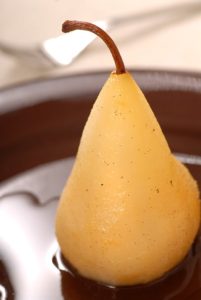
Pears for fresh eating; pears for cooking
When you select a pear tree, consider how you intend to use the fruit. Here’s how pears are classed for use:
- Dessert pears are for fresh eating; they are picked firm, ripened off the tree, and eaten out of hand.
- Culinary pears are for cooking; these pears do not ripen soft enough for eating out of hand; they remain firm and can be baked or cooked.
- Dual pears can be eaten fresh or cooked.
Pear tree pollination
- Few pear trees are self-fruiting. Pears yield best when they are matched with a cross-pollinator. Plant at least two cultivars.
- Pear varieties are commonly divided into pollination groups; the members of each group flower at the same time so they are good pollinators for other members of the group. It is important to plant at least two varieties from the same group (the same flowering time) to ensure pollination. (Pollination occurs when bees or other insects carry pollen from the flowers of one variety to the flowers of a second.)
- When you select a pear tree, the plant tag or label will tell you if the tree is self-fertile or list other pear varieties that are pollinators.
- Even self-pollinating cultivars will benefit from having a second variety that flowers at the same time nearby—a sort of pollination insurance policy.
Pear tree pollination groups
When you decide on the pear variety you want to grow, look at a pollination chart to make sure you select a second variety that is a pollinizer. Here are two examples of pollination charts:
Example One: Choose two varieties from the same flowering time group:
- Group A: ‘Chojuro’, ‘Korean Giant’, ‘Packham’s Triumph’, ‘Seckel’, ‘Tsu Li’.
- Group B: ‘Bartlett’, ‘Anjou’, ‘Conference’, ‘Harrow Delight’, ‘Hosui’, ‘Magness’, ‘Warren’, ‘Winter Nelis’, ‘Hessle’.
- Group C: ‘Beurré Bosc’, ‘Clapp’s Favorite’, ‘Concorde’, ‘Comice’, ‘Gorham’, ‘Moonglow’, ‘Max-Red Bartlett’, ‘Winter Nelis’.
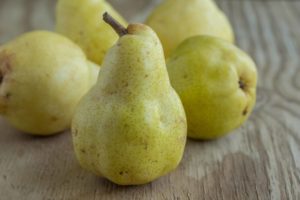
Example Two: Selected the variety you want to grow and match it with a compatible pollinizer. Here are popular varieties followed by pollinizers.
- ‘Bartlett’ pollinators include ‘Anjou’, ‘Bosc’, ‘Comice’.
- ‘Bosc’ pollinators include ‘Bartlett’, Comice’, ‘Anjou’, ‘Seckel’.
- ‘Anjou’ pollinators include ‘Bartlett’, ‘Bosc’, ‘Comice’, ‘Anjou’, ‘Seckel’.
- ‘Seckel’ pollinators include ‘Bosc’, ‘Comice’ (‘Bartlett’ is not compatible).
- ‘Chojuro’ pollinators include ‘Shinseike’, ‘Bartlett’.
- ‘Nijisseiki’ (also called ‘Twentieth Century’ pollinators include ‘Chojuro’, ‘Shinseike’, ‘Bartlett’.
- ‘Hosui’: self-fruitful or any other pear in the same bloom time.
- ‘Shinsike’ pollinators include ‘Chojuro’.
Some specific pear varieties will not pollinate other specific varieties:
- ‘Comice’ and ‘Bosc’ will not pollinate ‘Conference’ and vice versa.
- ‘Bartlett’ will not pollinate ‘Seckel’.
- Some Asian pears bloom earlier than European pears so they are not good choices for cross-pollination of European varieties.
- Later blooming Asian varieties will pollinate European varieties.
Pear tree rootstock
- Like many fruit trees, pears are grafted onto rootstocks that are adaptable to many soils or are disease resistant.
- There are two main types of pear rootstock: quince rootstock called ‘Quince A’ and a fireblight resistant pear rootstock called ‘Old Home x Farmingdale’–‘OHxF’.
- Most dwarf pears are grafted onto ‘Quince A’ rootstock; these trees grow to about 8 feet tall. Quince roots are shallow and pears on quince rootstock cannot tolerate drought or very cold soil (hardy only to 0°F or greater).
- ‘OHxF’ rootstock grows taller trees—from 10 to 15 feet tall—and is hardier than quince, withstanding colder winters. Choose a rootstock recommended for your region; check at a local tree nursery for advice or call the nearby Cooperative Extension Service.
Pear tree rootstock list
- Betulaefolia: Rootstock well suited for Asian pears. It can produce large trees in poor soil and is tolerant of both wet and dry conditions.
- Calleryana: Produces a large tree; it is tolerant of wet conditions.
- French Seedling: Rootstock commonly used for Bartlett and Winter Nellis pears. A good general-use rootstock.
- Old Home x Farmingdale: Somewhat dwarfing rootstock.
- OHxF Series: Several semi-dwarfing rootstock strains were developed at Oregon State University from Old Home and Farmingdale parents. These strains are disease resistant. The series includes OHxF40, OHxF513, OHxF87, and OHxF97.
- OHxF333: A semi-dwarfing rootstock; trees will grow from 12 to 20 feet tall or about half to two-thirds of normal size. Trees growing on this rootstock may be slightly smaller than other fruits but the yield will be high. Trees growing on this rootstock are resistant to fire blight and other diseases. Stake trees for the first 2 years.
- Quince: There are several strains of this semi-dwarfing quince rootstock used for pears. On this rootstock, the tree grows to about half of the standard size and are very productive. Quince rootstocks begin fruiting earlier than other rootstocks. Not all quince rootstock strains are compatible with all pear scion or fruiting parts.
- Quince A: Trees growing on this rootstock will grow 15 to 20 feet tall and can grow in poor soil. Stake these trees for the first 2 years.
Pear tree yields
- Standard and semi-dwarf pears yield 150 to 200 pounds of fruit each year.
- Dwarf pears yield about 30 to 45 pounds of fruit each year.
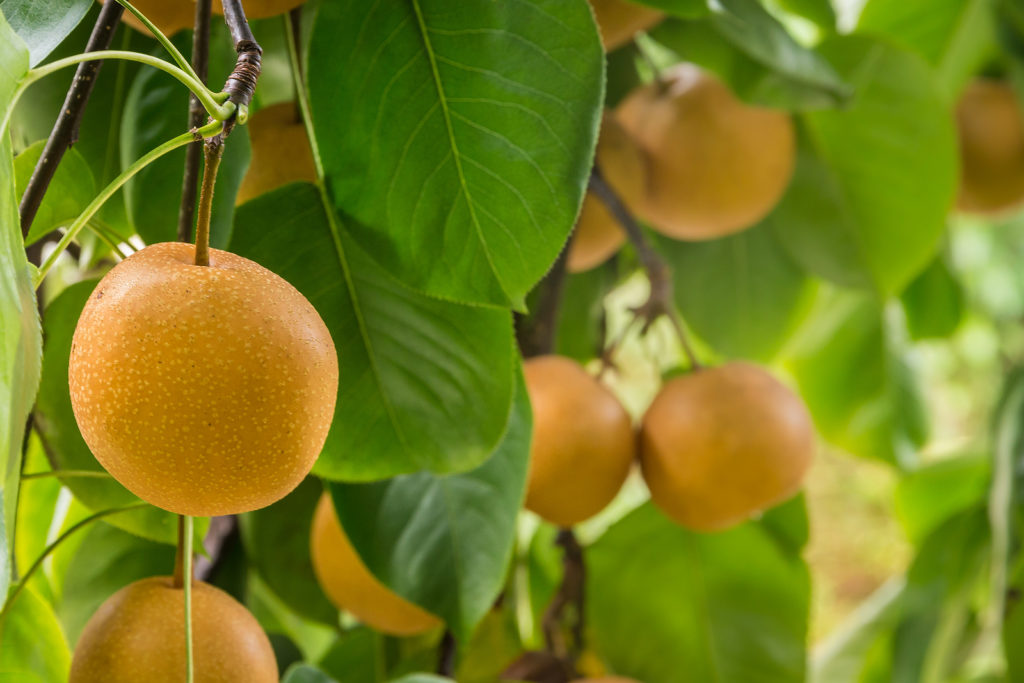
Container growing pear trees
- Dwarf pear trees can be grown in containers. Choose pears grafted on dwarf rootstocks.
- Choose a large pot or tub at least 18 inches wide and deep that is well-drained.
- Plant trees in a commercial organic potting mix.
- Keep the soil evenly moist but not wet.
- Feed pears growing in containers with an all-purpose fertilizer that is slightly higher in potassium.
- Repot the tree after two years into a container that is 24 inches wide and deep. Once the tree is full size, repot it every year when it is dormant; prune back the roots and tops before repotting.
- In cold regions, protect trees growing in containers by moving them to a protected place–a garage or covered porch–in frigid weather.
Watering pear trees
- Newly planted pear trees require moderate watering weekly. Set the water on low and allow it to seep into the soil; roots will follow deep watering and become well-established.
- An established pear tree requires only infrequent watering but be sure to water trees during prolonged dry periods.
Feeding pear trees
- Feed pears with a mulch of aged compost applied liberally around the base of the tree once or twice a year, in spring or in late fall after leaves have dropped.
- Feed pears after new growth start in spring; use a complete fertilizer that is lower in nitrogen than phosphorus and potassium. Too much nitrogen can spur leafy branch growth and leave pears vulnerable to fireblight disease.
- Low levels of potassium, calcium, or boron can reduce growth and fruit quality. Test the soil for its nutrient content. Spread gypsum on the soil to raise the calcium level.
- Yields can be improved with a foliar feeding of seaweed extract when buds begin to show color, again after petals fall, and once again when fruits are less than 1 inch in diameter.
- Protect young trees from frost by covering them with a floating row cover when frost threatens.
How to train a pear tree
- Pear trees are naturally upright growing with mostly vertical branches. Vertically growing branches tend to have narrow crotches which can easily crack or break when loaded with fruit.
- The strongest and most fruitful angle for a branch is 45 to 60 degrees; a branch with a narrower angle will be weak and could break off.
- A young pear tree can be trained to a single leader (main trunk) or to three or four leaders (multi-leader) form. Training to two or more leaders is insurance against leader damage due to limb breakage, wind damage, or disease.
Central leader method
- Central leader: A mature central-leader tree has a somewhat conical shape. The main stem is the central leader; from the central leader even spaced lateral branches are selected to grow as the tree’s scaffold branches. At planting a one- or two-year-old whip is cut off at about 30 inches above the ground; four even spaced lateral branches are selected to become the scaffold branches; all others are removed. In the second year, even spaced sub-lateral branches are selected to grow on; other sub-laterals are removed. Each year the central leader is shortened by one-third of the previous summer’s growth until the conical shape of the tree is established.
Modified central leader method
- Modified central leader: A modified central leader tree does not have a central main stem or trunk; the main stem is shortened in the second or third year and lateral-scaffold branches are encouraged to grow. Follow the training directions for a central leader form tree; once 4 or 5 strong scaffold branches have formed, cut back the central leader to just above the topmost scaffold branch. Sub-laterals will grow from the scaffold branches; prune these to keep the form of the tree and remove any vertical sub-laterals.
Training branches
- Training branches: In the first couple of years after planting, spread the branches each spring so that they do not shoot straight up; spread branches so that they grow 60 degrees from vertical; use a stick notched at each end to spread apart the two branches or hang a weight near the ends of one branch to hold it down and train it to a wider angle; begin this training each spring after blossoms fall.
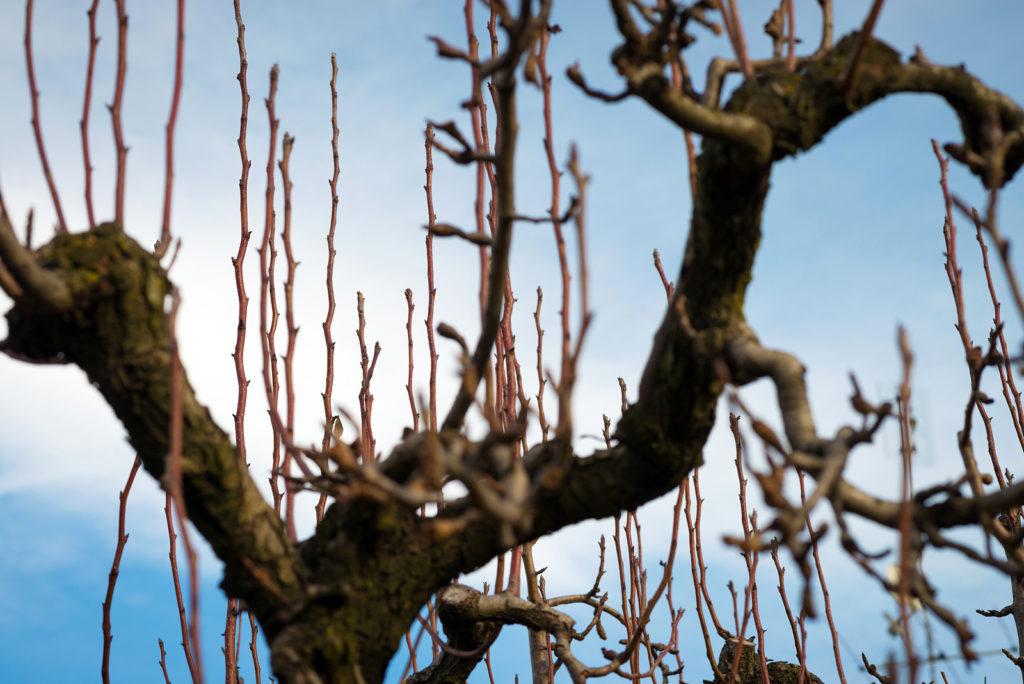
Pear tree pruning
If pears are left unpruned they will take longer to bear fruit. Pears send up tall, vertical shoots. They are best pruned to form a tree with 4 to 5 scaffolds around a central or main stem. Scaffold or horizontal branches will produce more fruit and should be encouraged. Remove the tips of scaffold branches to encourage the growth of lateral fruiting branches. Pears produce fruit on short, stubby lateral branches called spurs.
Pear trees are best pruned in winter when they are dormant.
There are several varieties of pear trees and habits of growth differ widely.
All pear trees produce fruit from spurs on wood two- and three years old. Fruiting spurs should be preserved when pear trees are pruned.
For a backyard pear tree, you can choose to train the tree to a central leader, a modified leader, or an open center. This training begins soon after the tree is planted and will take about three or four years.
Young pear trees tend to have upright–not spreading–growth. Early on encourage spreading branches and outward growth in your pruning choices. During the dormant season, head or trim back main framework branches by one-third to a half of their length. It is not necessary to trim backside shoots.
Pear trees have a general habit of sending up many vertical whip-like branches. This is especially true when the tree is young. Keep these whips cut back. Do not allow the top of the tree to grow too much upward; instead, direct the tree’s energy into the fruit-bearing spurs developing on older wood. Pear trees can be thinned during the growing season when growth is overly lush and crowded. Cut back unbranched shoots to about 18 inches.
Here are simple pruning cuts that you must perform from the tree’s first summer forward.
- Remove any broken, diseased, or dead wood from the tree.
- Prune away the weaker of two branches growing from the same spot.
- If two branches are growing in opposite directions, keep the branch that is best placed.
- If two branches cross or rub against one another, remove the weaker of the two.
- If two branches are growing parallel to each other, one over the other, keep the one that is best placed and remove the other.
- Cut back substantial whip growth by about two-thirds their length.
These cuts will help to thin out whip-like tall shoots that are almost ever-present near the center of a pear tree. Strive to keep the tree’s limbs and framework evenly spaced. It is essential that sunlight and airflow easily to the center of the tree for it to be healthy and productive.
In midsummer, thin fruit after some fruit has dropped. Thin to one fruit per spur.
Pear trees are susceptible to a bacterial disease called fire blight. This disease causes twig ends and leaves to take on a burnt or scorched look and to suddenly die. When blight is suspected it is important to remove twigs and limbs immediately. Cut back from the infection at least six to eight inch
Pear tree pruning step-by-step
- Prune pear trees in late fall after the tree has dropped its leaves and gone dormant or in early spring before new buds appear. Very light pruning can be done at any time of the year.
- Remove all diseased, dead, or broken branches. Prune off branches infected with fireblight, a bacterial disease.
- Remove crossing or rubbing branches. If two branches cross and rub against each other they can cause a wound that may allow insects or fungal diseases to attack the tree. Remove the least desirable branch.
- Remove all water sprouts. Water sprouts are fast-growing vertical branches that usually have no side branches.
- Remove all suckers. Suckers are fast-growing shoots that grow out of the soil from the roots below the soil surface.
- Pears send up many tall whip-like branches from the center of the tree; prune each year to keep the tree from growing too tall; head whip-like branches down.
- Head back side branches that grow taller than the central leader. Head back new whip growth by two-thirds of their length. Keeping a pear tree headed back will direct growth to the fruit-bearing spurs which develop on older wood.
- Do not prune in winter when bacterial canker is a problem; wait until spring when new growth has begun.
How to thin a pear tree
- Pears set fruit on short stubby spurs that develop on older branches. Spurs can vary in shape and length but they commonly have a knob-like end that is covered with new buds. When thinning shoots, be sure to leave ample fruiting wood; prune back shoots only if they grow longer than 18 inches; head back to a flower bud just before bloom this will stimulate fruit set.
- Spurs bear fruit year after year and should not be pruned off.
- After limbs set fruit, thin ends of all secondary branches to an upright shoot or bud; the fruit will then be borne on heavier wood rather than fragile branch ends.
- Pinching shoot tips in early summer before June drop will increase the final crop of slow-to-bear young trees.
- Four to eight weeks after bloom, thin fruits leave one or two fruits per cluster. Spot-pick mature fruits during the harvest to allow the fruits that remain to mature and grow larger.
- Thin crowded fruit clusters a second time to just one fruit about mid-season; if the crop is thin leave two pears per cluster.
- Remove small and blemished fruit a few weeks before picking the main crop.
- To prevent branches from splitting or breaking due to heavy crops, tie up the main scaffold branches with a strap or rope.
Pear flowering times and harvest times
Nearly all pears require cross-pollination from a second cultivar or variety that flowers at the same time. The exceptions are Bartlett, Red Bartlett–in dry western regions–and Kieffer and Turnbull. Choose varieties that overlap their flowering time. That means early and late varieties are not likely cross-pollinated. Plant at least two or even three pear trees to ensure pollination.
- Early season varieties: Aurora, Clapp’s Favorite, Max Red Bartlett, Moonglow, Orient, Packham’s Triumph, Red Clapp (Starkrimson), Tyson.
- Early to midseason varieties: Bartlett, Flemish Beauty, Moonglow
- Midseason varieties: Bartlett, Conference, Devoe, Douglas, Duchess, Fan Stil, Lincoln, Magness, Max-Red Bartlett, Maxine (Starking Delicious), Monterey, Parker, Pineapple, Seckel, Sensation Red Bartlett (Sensation).
- Midseason to late season varieties: Anjou (Beurre d’Anjou), Colette, Seckel, Warren.
- Late varieties: Anjou, Bosc (Beurre Bosc, Golden Russet), Comice (Doyenne du Comice, Royal Riviera), Duchess, Dumont, Gorham, Kieffer, Le Conte, Magness, Maxine (Starking Delicious), Mericourt, Orient, Patten, Seckel, Winter Nellis.
- Asian pear (apple pearv) varieties: Asian pears bloom earlier than European pears. They are usually finished flowering before European pears start, however, late-blooming Asian pears will pollinate European pears. Asian pears include Chojuro, Hosui, Kikusui, Korean Giant, Nijisseiki (Twentieth Century), Seigyoku, Shinko, Shinseiki, Sure Crop, Tsu Li, Ya Li (pear-shaped).
Northern Hemisphere harvest times
- July harvest: Clapp’s Favorite, Bartlett, Max Red, Shinseiki.
- August harvest: Shenseiki, Ya Li, Moonglow, Seigyoku, Chojuro, Nijisseiki, Fan Stil, Pineapple, Kikusui, Anjou, Seckel, Monterrey.
- September harvest: Anjou, Seckel, Monterrey, Sure Crop, Maxine, Kieffer, Bosc, Winter Nellis, Comice.
- October harvest: Kieffer, Bosc, Winter Nellis, Comice.
How to harvest pears
Bartlett pears come to harvest in summer; most other varieties come to harvest in early autumn. European pears such as Bartlett and Comice ripen to perfection only after they are removed from the tree having been picked still green and hard. Allow these pears to ripen on the counter at about 75°F/24°C. Asian pears ripen on the tree and do not have to be picked and cured like European pears.
- Standard and semi-dwarf pear trees bear a full harvest five to seven years after a whip is planted.
- Dwarf varieties begin to bear fruit three to five years after a one-year-old whip is planted.
- Pears come to harvest from midsummer to mid-autumn, depending on the variety.
- A pear is ready for harvest when it reaches mature size and the green color lightens but the fruit is still hard. The stem of the fruit will part readily from the spur when you lift up on the fruit with a slight twist. If the stem does not snap on its own, wait a couple of days and try again.
- The fruit will ripen off the tree in a cool place. Pears that fully ripen on the tree can have a grainy texture.
How to store pears
Pears harvested green can be stored in a cool place–where the temperature does not exceed 75°F/24°C–for ripening and use in winter. Pears will store in a cool place for up to 12 months depending upon the variety. (Pears are not recommended for freezing.)
To store pears, place them in a box or on paper trays where they will not touch and air can circulate around the fruit. Pears in storage should not be exposed to freezing temperatures and should be safe from rain and pests. Check the fruit weekly to remove any soft or decaying fruit. Remember: “One bad pear can spoil the lot.” When you are ready to use stored pears, allow them a day or two to ripen on the counter.
- Store pears at high humidity and temperatures near freezing. The length of storage varies with the cultivar, but some pears will store for up to three months. Remove the fruit from storage and ripen it before you eat it. Pears that are hard when they fall from the tree will soften in storage.
Using pears in the kitchen
How you will use the fruit you harvest is an important question when choosing a pear tree. There are pears for eating fresh out of hand or slicing for salads (dessert pears) and pears for cooking and baking (culinary pears). Asian pears are best eaten within a few days of picking. European pears are commonly stored for a month or two or more before eating. European pears ripen while in storage.
Here are pear varieties that are excellent in their categories:
- Fresh eating and salad pears: Bosc, Colette, Comice, Magness, Max-Red Bartlett, Seckel, Seigyoku, Shinseiki, Ya Li.
- Cooking pears: Kieffer, Seckel, and Winter Nellis.
- Canning pears: Colette, Maxine (Starking Delicious).
Pear tree propagation
- Pear trees can be grown from seed.
- Pears grafted onto quince or ‘Farmingdale-Old Home’ rootstock grows best.
Pear tree problems and controls
- Fireblight is a bacterial disease that causes branches to blacken and die. Cut back infected branches to green, healthy growth. Disinfect pruning tools with bleach between pruning cuts. Plant fireblight-resistant varieties if you live where summers are warm and humid. There is no cure for fireblight.
- Pear psylla is a small sucking insect that attacks leaves and branches. Spray pears with a dormant spray or all-season horticultural oil to control overwintering pests such as psylla. Kaolin clay in the form of an organic spray can be used as a protective barrier against psylla; spray the whole tree.
- Codling moth larvae burrow into fruit leaving black frass where they enter. Pick off and dispose of damaged fruit regularly; when you do this, you will be disposing of the coddling moth larvae and will interrupt the pest’s life cycle. Pheromone traps can control coddling moths.
Pear varieties for backyard gardens
European pears have a classic pear shape; the fruit is soft, juicy, sweet ripe. Asian pears are round, shaped like an apple; the flesh is firm when ripe but also sweet.
European
European pears are commonly sold and eaten during wintertime. They come to harvest in late summer and fall and ripen off of the tree after the harvest. European pear varieties require at least 600 hours of winter chill (temperatures of 45F/7C or lower) to be productive; the optimal chill time for European pears is 900 hours. Pears are hardy to -20°F/ -29°C. European pears include Anjou, Bartlett, Bosc, Colette, Comice, Flemish Beauty, Magness, Max-Red Bartlett, Moonglow, Seckel, Sure Crop, Winter Bartlett, and Winter Nellis.
Asian
These are round, crisp, and sweet pears that ripen on the tree. They are also called apple pears or salad pears. Asian pear varieties require as few as 400 hours of winter chill. They are a very good choice for warm winter regions, USDA Zones 9 and 10; they do not grow as well in very cold winter regions. Asian pears include Chojuro, Hosui, Korean Giant, Nijisseiki, Seigyoku, Shinseiki, Tsu Li, Ya Li.
Hybrid
Hybrid pears are a cross between European and Asian pears. They have a lower chilling requirement than European varieties. Hybrids are more similar in appearance to European varieties than Asian varieties. Hybrid pears include Fan Still, Kieffer, Maxine (Starking Delicious), Monterrey, Orient, and Pineapple.
 Early harvest European pears
Early harvest European pears
- ‘Clapp’s Favorite’: large fruit resembles Bartlett but more heavily blushed; soft, sweet flesh; good for fresh eating and canning; ripens early; very susceptible to fireblight; hardy in cold late-spring regions; good in north and west.
- ‘Flordahome’: small to medium-size fruit; light green skin; juicy; ripens early; needs little winter chill—a good choice for warm-winter regions; fireblight resistant.
- ‘Harrow’s Delight’: resembles Bartlett but smaller; smooth texture, good flavor; ripens early; an excellent choice for cold winter regions; very resistant to fireblight.
- ‘Moonglow’: resembles ‘Bartlett’; juicy and soft with good flavor; ripens early; very resistant to fireblight.
- ‘Orient’ (hybrid): round, firm flesh; good for canning; resistant fireblight; good grower in southern gardens.
- ‘Packham’s Triumph’: originally from Australia; green skin; very good flavor; flowers very early so must be protected from frost; ripens late.
- ‘Red Clapp’ (‘Starkrimson’): a sport of ‘Clapp’s Favorite’; good quality, red-skinned; susceptible to fireblight; grow in west and north.
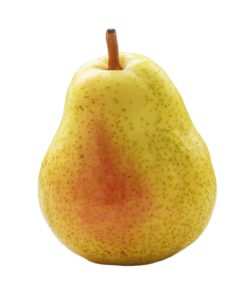
Mid-season harvest European pears
- ‘Bartlett’: medium to large fruit; short neck; thin skin; yellow to slightly blushed; sweet and tender; ripens midseason; susceptible to fireblight; often self-fruitful’ grows well in all zones.
- ‘Blake’s Pride’: medium-size fruit, yellow to gold skin with light russeting; very good flavor; ripens midseason; highly resistant to fireblight.
- ‘Flemish Beauty’: old commercial favorite; great flavor; ripens midseason; very susceptible to fireblight.
- ‘Gorham’: heirloom American variety; oblong to slightly teardrop-shaped; greenish-brown russeted skin; sweet, musky flavor; ripens late midseason.
- ‘Highland’: yellow skin with russeting; excellent flavor and texture; stores well; grows well in the northwest.
- ‘Lincoln’: large fruit; extremely hardy; blight-resistant; good in north, south, and Midwest.
- ‘Magness’: medium size, oval fruit; greenish-yellow tough skin with dark spots; soft, juicy flesh; resistant to fireblight.
- ‘Maxine’ (‘Starking Delicious’) (hybrid): large fruit; juicy sweet, white flesh; resists blight; good for north and south.
- ‘Max-Red Bartlett’: resembles ‘Bartlett’ but has bright red skin; sweet flavor; ripens midseason; susceptible to fireblight.
- ‘Nova’: large round fruit; juicy flesh; ripens midseason; very hardy; recommended for cold winter regions.
- ‘Parker’: medium to large fruit; yellow with red blush; juicy, sweet, white flesh; upright grower; fairly hardy; susceptible to fireblight; good grower in the north.
- ‘Potomac’: medium-size fruit; light green skin with a red blush; very good flavor; ripens midseason; fireblight resistant.
- ‘Rescue’: large fruit—pear-shaped; yellow skin blushed red-orange; sweet and juicy, smooth texture; ripens midseason.
- ‘Seckel’: small, round to pear-shaped; yellow-brown skin; granular texture, sweet and aromatic; ripens early midseason; fairly resistant to fireblight; self-fertile.
- ‘Sensation Red Bartlett’ (‘Sensation’): yellow ski blushed red, white flesh; susceptible to fireblight; good grower in the west, difficult in the north.
- ‘Ure’: small, round fruit; greenish-yellow skin; sweet and juicy; ripens midseason; cold-hardy hybrid—an excellent choice for very cold winter regions; fireblight resistant.
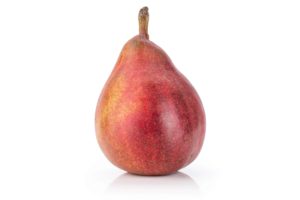
Late-season harvest European pears
- ‘Anjou’ (‘d’ Anjou’, ‘Beurré d’Anjou’): medium to large fruit; round with short neck; yellow or russeted yellow; ripens late; moderately susceptible to fireblight; not for hot summer regions or northern gardens.
- ‘Bosc’ (‘Beurré Bosc’, ‘Golden Russet’): medium to large fruit; long neck; heavy russet on green or yellow skin; firm, juicy, flavorful; ripens late; very susceptible to fireblight; good grower in north and west.
- ‘Comice’: large fruit; round to pear-shaped; thick greenish-yellow skin russeted or blushed; ripens late; susceptible to fireblight; usually self-fertile; best with pollinizer; good grower in the west.
- ‘Concord’: a tear-drop shape with a long neck; russeted green-brown skin; excellent flavor; stores well; ripens late.
- ‘Conference’: large, elongated fruit; yellow skin; very juicy and sweet, buttery; ripens late; good resistance to fireblight.
- ‘Duchess’: large, fine-textured fruit; good flavor; good grower in the north.
- ‘Hessle’: heirloom English variety; small to medium fruit with conical shape; yellow skin; white flesh sweet and mild; for cooking; ripens late.
- ‘Kieffer’ (hybrid): large yellow fruit; gritty flesh; excellent for cooking; need little winter chill; withstands cold and heat; grows in most areas.
- ‘Mericourt’: yellowish skin blushed with red; white flesh; grit-free; eat fresh or can; fireblight resistant; good grower in southern gardens.
- ‘Warren’: medium to large fruit with teardrop shape; pale green skin with red blush; juicy with excellent flavor; ripens late; a good choice for cold winter regions; resistant to fireblight.
- ‘Winter Nelis’: small to medium roundish fruit; rough, dull green or yellowish skin; very good flavor; good for baking; ripens late; moderately susceptible to fireblight.
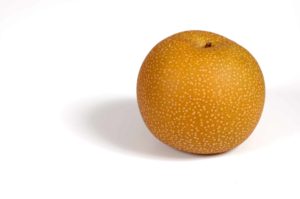
Asian pears
The Asian pear is a different species from the European pear. It is a good choice for growing in the South and West; it does not grow as well as European pears in very cold winter regions.
- ‘Dan Bae’: Korean cultivar; olive green fruit; stores well; late harvest; grows well in the northwest.
- ‘Chojuro’: large fruit; russeted brown to orange skin; crisp, juicy, light spice flavor; ripens midseason.
- ‘Hosui’: large fruit; bronzy orange, russeted skin; very good flavor; ripens early; self-fruitful or match with any other pear in the same bloom time; susceptible to fireblight.
- ‘Kieffer’ (hybrid): medium to large oval fruit; yellowish skin blushed dark red; fair flavor, gritty texture; a good choice for baking; ripens late; fireblight resistant.
- ‘Korean Giant’: extra-large fruit; russeted olive green; ripens late.
- ‘Nijisseiki’ (also called ‘Twentieth Century’): small, round fruit; yellow with white skin; juicy, sweet, crisp flesh; ripens midseason; self-fertile.
- ‘Seuri’: medium size; orange skin; blight resistant; late harvest.
- ‘Shinko’: medium to large fruit; bronze-russet skin; flavorful; ripens late.
- ‘Shinseike’: medium to large fruit; smooth, greenish-yellow skin, white crisp flesh; sweet flavor; ripens early; self-fertile; disease resistant.
- ‘Tsu Li’: elongated fruit; yellow-green skin; aromatic flesh with good flavor; ripens late; some resistance to fireblight.
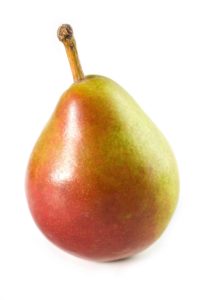
Favorite European pear varieties to grow
- ‘Anjou’: large, greenish with pink blush; good flavor and texture; midseason harvest.
- ‘Bartlett’: standard summer pear; medium to large; thin-skinned; yellow; very sweet, very tender; midseason harvest.
- ‘Bosc’: medium to large; russeting on green or yellow skin; good flavor, firm, juicy flesh; holds shape when cooked; late harvest.
- ‘Comice’: large to very large; thick greenish-yellow skin; great flavor and texture; late harvest.
- ‘Seckel’: self-fruitful; bears heavily with pollinizer; small; yellow-brown skin; very sweet; a good choice for home gardens; good for canning; early mid-season harvest.
- ‘Ure’: cold-hardy hybrid developed in Canada; small, round fruit; greenish-yellow skin; sweet and juicy; use fresh or canned.
See also: Pear Varieties for Backyard Gardens

Favorite Asian pear varieties to grow
- ‘Chojuro’: oblong; greenish-brown; white flesh; mildly sweet; harvest midseason.
- ‘Housi’: medium to large; brownish skin with rose and yellow undertones; excellent flavor; late harvest.
- ‘Seuri’: large, orange fruit; delicious flavor, late harvest.
- ‘Shinko’: medium; bronze, russeted; juicy, sweet flavor; late harvest.
- ‘Shinseiki’ (‘New Century’): large; yellow skin; white flesh; sweet, juicy; early harvest.
- ‘20th Century’ (‘Nijisseiki’): medium size; clear yellow skin; white flesh; sweet to slightly tart; harvest mid-season.
Also of interest: How to Choose a Pear Tree for Planting
Related articles:
Planning the Home Fruit Garden
Garden Planning Books at Amazon:
- Vegetable Garden Almanac & Planner
- Kitchen Garden Grower’s Guide Vegetable Encyclopedia
- Vegetable Garden Grower’s Guide
- Tomato Grower’s Answer Book
More fruit-growing articles:
Learn how to plant, grow, prune, and harvest your favorite fruits. Click below for all you need to know.
- Apple
- Apricot
- Avocado
- Banana
- Blackberry
- Blueberry
- Cantaloupe
- Chayote
- Cherimoya
- Cherry
- Citrus
- Clementine
- Cranberry
- Currants
- Elderberry
- Feijoa
- Fig
- Gooseberry
- Grape
- Grapefruit
- Guava
- Kiwifruit
- Kumquat
- Lemon
- Lime
- Loquat
- Mandarin
- Mango
- Melon
- Mulberry
- Muskmelon
- Nectarine
- Olive
- Orange
- Papaya
- Passion Fruit
- Peach
- Pear
- Persimmon
- Pineapple
- Pineapple Guava
- Plantain
- Plum
- Pomegranate
- Pumpkin
- Quince
- Raspberry
- Strawberry
- Tangelo
- Tangerine
- Tangor
- Watermelon


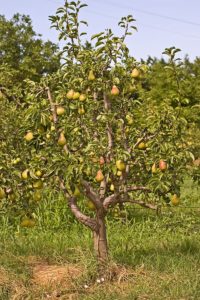 Early harvest European pears
Early harvest European pears












